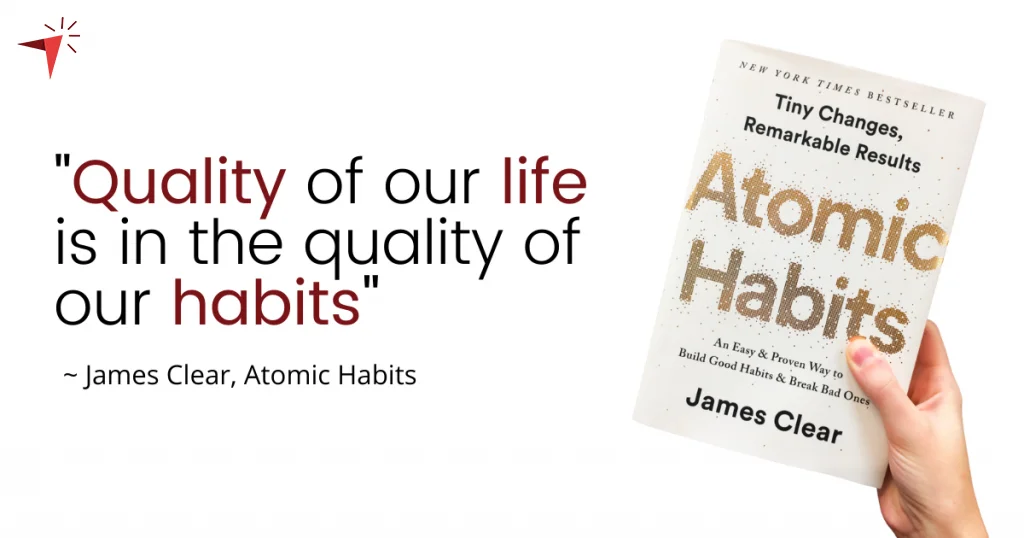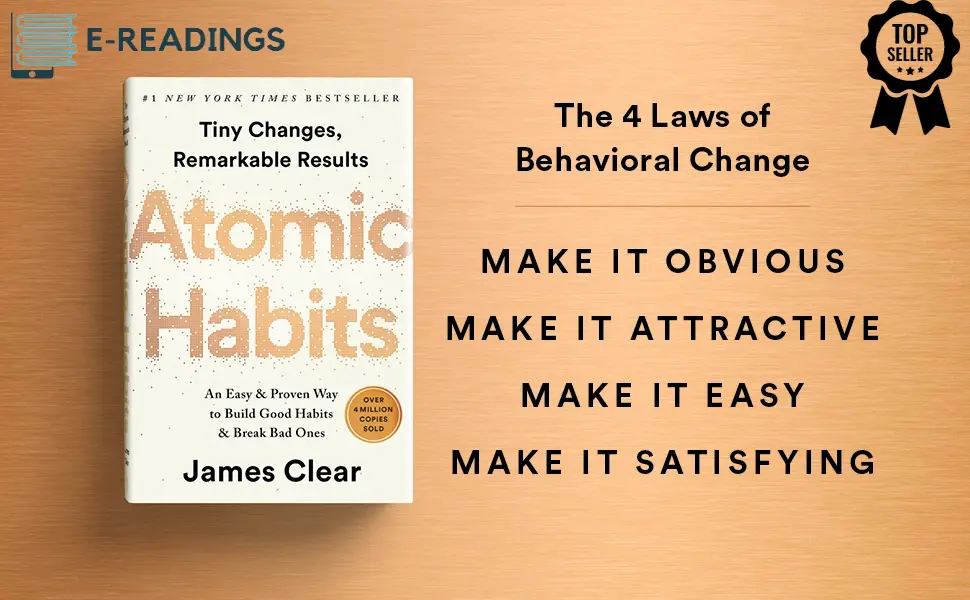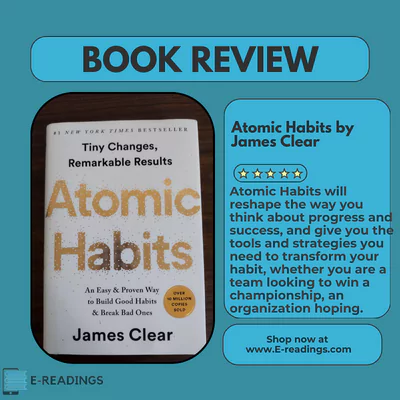Friends, today we will learn with one of the best Books on Habit Building, “Atomic Habit,” written by James Clear, how to develop it scientifically with the help of practical and powerful methods. How can we build any new habit or give up any old bad habit? We will know how small steps and efforts create big results and why we quit our habits midway even if we want to.
And how we stick to them, build or quit any habit, and change our behavior and habits by shifting our identity. Now, friends, in this article, I will explain this book to you as much as possible by summarizing it easily and simply. So that you not only like hearing these steps but you can also follow them practically daily to make your life right today.
Believe me, this book is the most powerful and practical book on habit building.
Main Theme:
The main theme of this novel is making us responsible and habitual people. James tells us how we can achieve our goals in less time by working accurately on them and without wasting our time doing unrewardable things that waste a lot of time.

James also tries to make us normal people who have all the abilities to achieve high goals in a good way and with zero failure percentage.
Genre:
This book is full of motivation and comfort sacrifice to achieve your goals. The author gives us the instant motivation not to give up or struggle. So, this book is for anyone who wants to be successful in their life. Atomic Habits is all about showing you how small adjustments can lead to a massive transformation in your life.
There is no age restriction
Main points:
So these are the main points debuted in the novel that we’ll follow in our lives.
1: The 1% rule:
Most people think that to achieve something big, we need to take big steps every day.
But if we look at it in the bigger picture, it would be wrong to say this because, according to James Clear, the compounding effect does not only work in financial investments but also applies to our daily lives and habits.
Now, compounding is applicable in both cases, whether you are following good habits for a long time or bad habits, but if you are following self-improvement and want to build effective habits. So James says that if you improve even by just 1% every day, you will have grown 37 times more at the end of the year, so you have to forget the overnight results and focus on taking small steps and consistency every day. Because positive results are the by-product of your daily peak improvements, habits have a compound interest in self-improvement.
| Publisher | Avery |
| Publishing Date | First published October 16, 2018 |
| Language | English |
| Pages | 306 Pages |
| Series | Atomic Habits |
| Literary awards | Goodreads Choice Award Nominee for Nonfiction (2018) |
| ISBN-10 | 1668001225 |
| ISBN-13 | 978-1668001226 |
Now, yes, if we look at it daily, the impact of our habits is negligible. But if seen with a bigger vision, these habits show their effects in a few weeks, months, or a few years, and then the results are much more significant and visible, sometimes even more than our expectations. In this world of instant gratification, it has become difficult for us to follow our habits for the long term because of instant product delivery, instant information, instant content, and the opportunity to get everything instantly in a few clicks.
2: Clear’s plateau of latent potential:
Our brain is wired for instant gratification and instant results, but if we adopt the thinking and habit of delayed gratification, we can adequately understand James. The path of progress looks pretty straight and linear to us, but in reality, this path is long, crooked, and completely different from expectations.
James says that habits do not show any visible result until we break a threshold, and it takes a very long time to do this long period; many times, we become demotivated and leave our work, goal, or habit midway when we do not see any results. So, if you want to follow a solid habit, you must remember even the path full of disappointments.
This means that you must be prepared for many disappointments and failures, and you should continue until you cross the plateau of latent potential.
3: The Cycle Of Habits:
Triggers our brain to take action. Why is there laziness in the morning? Craving for morning tea. It provides a motivational force to do work or a habit like after tea; the energy and aroma of tea are your cravings. Responses are those habits and actions that we do. Your making or preparing tea is the response and reward, and the goal of each habit, i.e., feeling awake and energetic and drinking tea is your reward.
The first two steps, cue and craving, are problem-based, and the last two steps, response and reward, are solution-based phases. This habit cycle applies to both your good and bad habits, and James says that four laws of behavior change are influenced by this cycle, which we will understand properly in the next point.
4: Four Laws Of Behavior Change:
So, the first law makes it obvious and applies to the cue, and the second law makes it attractive. It applies to your craving, the third law makes it easy and applies to the response, and the last fourth law makes it satisfying and applies to rewards, so, for example, let’s assume that you want to develop the habit of book reading. You can keep a book near your bed in the morning so that it will become obvious.
When you sleep on the bed at night, you will see the book on the side of the bed, and it will be attractive for you to read while lying comfortably in the blanket with the book in your hand. It will be easier to do this than to go and find the book on the shelf. You will get satisfaction by taking out or reading, sitting on the decks, and finishing one chapter every day, and if you want to break any habit, you have to do these.

You have to do exactly the opposite of loss. For example, if you want to quit cigarettes, then first you have to make them invisible; that is, you do not have to buy them, nor do you have to keep them in your hands. It would help to keep it in a bag, pocket, or home.
Second, you have to make it unattractive; that is, you can join a gym so that along with being fitness conscious, you find a healthy diet attractive and cigarettes unattractive.
Third, You have to make it difficult; you have to not hang out with your smoker friend, you have to change the route from the shop where you buy cigarettes every day, and you have to tell everyone that if they see you smoking, they will call you a loser and take fort that you should follow these dos to break or quit a habit.
5: Focus on Systems:
James says that we should focus more on daily systems rather than on goals; that is, if our daily process is productive and disciplined, then we can achieve what we want in the long term, and we also move forward on this point, only then we will present the How to Achieve Goals for you only after early goal setting.
Both winners and losers set goals, but only those who know the system to achieve them can achieve them. So your focus should be on something other than playing, but on some numbers, you will not be able to enjoy the process, whereas if you focus more on the system of playing and enjoy, then you can score more runs than you expected. If you are focusing only on the goal, you might think that you will feel happy or good only when you achieve your goal, which means that you are postponing your happiness and satisfaction.
“If you don’t stop improving, you will always get lasting results.”
James Clear, Atomic Habits
The second layer is the process, i.e., going to the gym daily, eating healthy, taking daily actions, and following your habits; the third and deeper layer is changing your identity, that is, if you consider yourself fit.
6: Shape Your Identity:
James says that when you are offered a cigarette, the first person says, no thanks, I am trying to quit smoking, whereas the second person says, no thanks, I am not a smoker. This is a very small difference, but this is the power of language. So, your goal should be something other than becoming a millionaire and a good businessman.
How you can put all this knowledge to use for yourself?
The easiest and most practical way for me is for you to figure out your current habits, basically to keep a habit scorecard. If you’re unaware of your productive or unproductive habits, there is no way to change them. And the thing about habits is they’re automatic.
That’s the whole point. It’s automatic. So you need to bring your awareness out so you can figure out the habits before you can change them, eliminate them, and improve on them, whatever the case is, in your situation. So habits scorecard.
“Habits are the compound interest of self-improvement”
James Clear, Atomic Habits
As you go through your day, whether at work or in your personal life, I want you to keep track of the cues and the rewards. As a reminder, the cues can be something like a smell, conversation, or location. It triggers your brain to look for a certain type of reward. Every time you open the fridge, you look for a cookie or something unhealthy, or whenever you get bored, you pull out your phone. Pulling out your phone is the reward.

Figure out what the cues are. Figure out what the rewards are, and then review your scorecard. You’re going to see a lot of unhealthy habits. And once you see all of this, armed with this information, you can make decisions to improve your life based on the framework of a tummy habit. But it all starts with awareness, cues, and rewards. Keep a habits scorecard for a few days. You don’t have to do it for months upon months. Could you do it for a few days? Review the results. You’re going to be blown away. It’s going to give you a better view of yourself.
1% Improvement daily:
If you make tiny 1% improvements to something daily in just one year, you are 37 times better. Imagine 37 times better health or 37 times better finances or relationships.
Here are some of the most pleasing quotes from the book:
“If you don’t stop improving, you will always get lasting results.”
“Habits are interest on investments in self-improvement.”
“You are not raised by your objectives but lowered down by your structure.”
“If you want to excel, you must remain constantly in wonder of what you do.”
My Review:
This book was amazing and is one of the world’s best motivational novels. This book made me stronger in achieving my goals and not giving up. When I read its main points about life to follow, they renew my energy for work. This motivational novel tells me that “NO PAIN, NO GAIN”.
If you are working on your dreams hard and in a good way, you will achieve them, and no one can stop you from achieving them. I like James’ way of motivating us very well without making us feel guilty. He has a very good accent in describing the rules as he is in front of us and teaching us the lesson to succeed in life. I follow all of the points he has told in the novel.
Conclusion:
At the core, the novel provides a complete way for personal growth and development and encourages us to adopt the power of total progress. The book is great for people who want to succeed in life and be a better person. If someone wants to be better, they can follow the points made by James in the book of Great Success. I recommend you buy this book as soon as possible to be a good and hardworking person without wasting your time. Go and grab this novel and start your new journey toward success.
